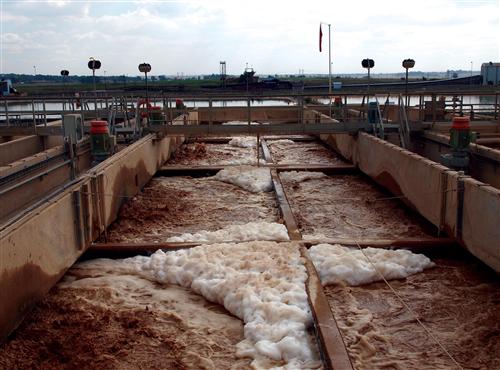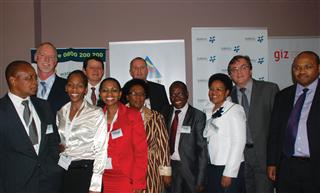South Africa must urgently find ways to control the rising groundwater levels in the gold mining area of Gauteng. In line with this, the South African government has undertaken to start pumping water from the affected mining basins as from 2012 – a programme that may have to continue for decades, if not centuries. The aim is to restrict the release of acid mine waters to a minimum. Several brand new facilities will treat the water to a point where it can be utilised for a variety of purposes, not yet determined. In other words, the strategy is to turn acid mine waters into a resource.
The government also plans to re-route certain smaller streams, to prevent surface water from reaching the old mines. Apart from these solutions, experts suggest further swift, responsible and strong action from the public and private sector. Mining companies should be storing acid-forming mining waste in the way that causes the least possible damage. One way of doing that is to mix it with a neutralising material. Another is to store it deep underground, well below the groundwater. Very little oxygen would reach the rock and waste material in such a place, and that would minimise the chemical reactions that form acid.
Experts also suggest that the mining industry should be subjected to close monitoring by experts in environmental and water management who have the appropriate qualifications. They would need to develop a database of environmental hazards posed by this sector and keep it under continuous review.
In the medium-term, companies and governments also need to join forces in tackling the country’s legacy of mine dumps and tailings dams. These dumps and dams contain valuable quantities of low-grade gold, increasingly accessible thanks to improving technology. Many are being remined and reprocessed, and the slimes emerging from the process are despatched to “mega-dams” located far from existing settlements and watercourses. The dumps and dams still in existence need to be isolated from groundwater, and the filtration systems used to remove wastewater need to be of the highest standard. The barren slopes of the dumps and dams need sensitive rehabilitation, as do the open erosion gullies of abandoned tips on coal mines.
All of these options translate into a huge amount of work for partnerships between public and private organisations; and the costs of all these measures will amount to billions, a considerable part of which will have to be shared by mining companies still in operation.

Oxide precipitation facility at Emalahleni, South Africa.
Source:Kruchem 2011
( click to enlarge )
A model initiative of two private companies was set up slightly outside the Orange-Senqu River basin:
Box: The eMalahleni Water Reclamation Plant – a Model
In 2008, the eMalahleni Water Reclamation Plant was set up just outside eMalahleni as a joint venture involving two large global resource firms, Anglo Coal and BHP Billiton. Each company operates several coal mines in the area.
Due to mining industry requirements, demand for water in the eMalahleni region is growing by 3.5 percent annually. This motivated the two companies to act as responsible coroporate citizens – in close cooperation with the eMalahleni Municipality. Since 2008 the new water reclamation plant has been taking acid mine waters from four local mines and converting it into drinking water of the finest quality. Producing 32 million litres of water per day, it is supplying a quarter of eMalahleni’s drinking water demands.
The acid mine water arriving at the plant is first collected in two ponds, from which it is pumped into a bubbling tank where limestone is added, plus large amounts of air. The result is that the water becomes alkaline, its iron and manganese content oxidises, and the result is a brown foam (see the photograph above).
Next the foaming water passes to a pond where reagents are added. These separate out the iron and manganese oxides and gypsum is formed by the action of sulphuric acid on limestone. The cleaned water then flows through sand filters, while the solids settle out as sludge. This is pumped to a drying facility where it is compressed into bricks. These bricks from iron, manganese and gypsum are an excellent building material. It is non-toxic and if it is used correctly, houses built with these bricks, are completely stable, even in the worst of rains.
Emerging from filtration, the water is almost clear, but still a little murky. It then flows through fine membranes that trap a wide variety of suspended particles, even those with diameters as small as a thousandth of a millimetre.
Finally, the water arrives at a membrane super-filter, which works by reverse osmosis system. Only about two-thirds of the water content goes through, resulting in water so pure and clean that it is the equivalent of distilled water. Indeed, it is too pure for humans to drink and for this reason it is re-mineralised with a little limestone. Thereafter, it is pumped into large concrete tanks, ready for drinking.
Water that on the first pass fails to make it through the reverse osmosis membrane is passed through the fine filters two more times. In the end, 99.5 percent will have been transformed into first-rate drinking water. All that remains is a trace of brine that is sent for safe disposal.
The “eMalahleni Water Reclamation plant is a non-profit project of Anglo Coal and BHP Billiton. The two companies have invested 700 million Rand to build this facility, but have written it off as social investment in the surrounding community. That leaves them with a water purification cost of about eight Rand per kilolitre, but they only recoup a portion of that from the revenues they receive from the municipality. EMalahleni charges paying consumers about seven Rand a kilolitre.
Whatever their revenues, Anglo Coal and BHP Billiton plan to expand the plant’s daily water purification capacity to 50 million litres by 2013. However, the configuration of the eMalahleni plant would not be suitable for treating radioactive waste water from gold mines. So, further research and development is required in order to transplant the technology directly to the Gauteng region.
 Members of the eMalahleni Water Reclamation Plant Public-Private-Partnership consortium, present at the signing of the cooperation agreement. Source:Vogel 2011 ( click to enlarge ) |
